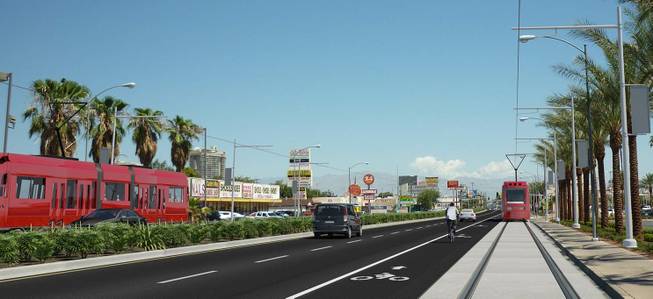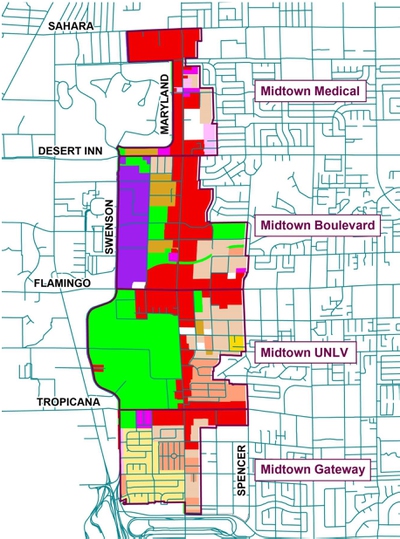
Regional Transportation Commission
A proposal to build an urban light rail or bus rapid transit system on Maryland Parkway between McCarran International Airport and downtown Las Vegas is moving forward. This image from the Regional Transportation Commission shows a version of the proposal that involves running light rail lines down both sides of the street.
Wednesday, Sept. 20, 2017 | 2 a.m.
The group working to reinvigorate the Maryland Parkway corridor recommends dividing it into four distinct districts, linked by a high-capacity transit system.
The Maryland Parkway Coalition unveiled the districts at a community meeting last Thursday at the Winchester Community Theater. Midtown Medical is located between Sahara Avenue and Desert Inn Road; Midtown Boulevard between Desert Inn and Flamingo Road; Midtown UNLV between Flamingo Road and Tropicana Avenue; and Midtown Gateway south of Tropicana.
An 8.7-mile high-capacity transit system would link various activity centers between McCarran International Airport and downtown Las Vegas. An estimated 35,000 residents work in the corridor.
The route could be extended to the Las Vegas Medical District, where the UNLV School of Medicine is located, on Charleston Boulevard west of Interstate 15, This would link UNLV's main campus with Sunrise Hospital, the medical school and University Medical Center.
“There are some key institutions that generate a lot of transit riders,” said David Swallow, senior director of engineering and technology for the Regional Transportation Commission. “(They include) universities, hospitals, airports and downtowns, and we (even) got a mall (the Boulevard) on this one line. It’s amazing how it’s worked out that way.”
UNLV President Len Jessup said that having public transit on a fixed route between the main campus and the medical district would be a huge step for the university.
“Going back and forth from the medical school, the dental school or any of the other health sciences programs that are going to be down there, they can make that loop multiple times a day and never have to get into their car,” Jessup said in his State of the University speech Thursday.
Two options are being considered for the high-capacity transit system — bus rapid transit and light rail.
Each light rail car would hold 140 passengers; the bus rapid transit would hold 90 passengers per vehicle.
Light rail’s estimated capital costs are $573 million to $705 million; bus rapid transit is $298 million to $367 million. Light rail would cost $220 per hour to operate and maintain, while the bus rapid transit would run about $96 per hour.
Both options would have a dedicated lane, and Maryland Parkway would be reduced to two lanes for automobiles. The dedicated transit lane would serve as a de facto turn lane for automobiles. Increased pedestrian and bicycle safety measures would be implemented as well.
Local officials got the go-ahead to look for funding to build the light rail line in June, giving the RTC until the end of 2020 to ask Clark County voters whether sales taxes should be increased to help pay for the planned transit system.
The earliest the light rail could be transporting riders on Maryland Parkway is 2023, Swallow said.
Swallow said Maryland Parkway is preferred over Las Vegas Boulevard for a mass-transit plan because of the area’s density and the characteristics of its neighborhoods.
“There are over 90,000 residents in the study area … between the airport and downtown Las Vegas,” Swallow said. “More importantly, when you look at the percentage of households that do not have a car within proximity to Maryland Parkway, over a quarter of the households do not have a car.”
That rate is over three times the rate of the valley overall, Swallow said, which demonstrates the need for mass transit in the area. Additionally, 46 percent of the households in the corridor are considered low income, which is nearly double the rate of the valley overall.
Swallow also noted that the bus route on Maryland Parkway is second only to the Strip as the valley’s most productive route.
“When you look at what Maryland Parkway does, it connects to transit routes,” Swallow said. “It goes north-south. And our busiest transit corridors are east-west. So it’s providing that vital connection between our transit network. It intersects our top five busiest routes. … It’s literally connecting the valley via the transit network.”
With UNLV looking to develop Maryland Parkway with a bevy of planned projects, Jessup said it all fits into the future vision for the area.
“We continue to work on the Maryland Parkway corridor, especially near the Harmon Gateway,” Jessup said. “In 60 years, Maryland Parkway will be completely transformed. Think of Mill Avenue in Tempe, Ariz.”
The RTC is set to publish the results of an environmental assessment, which began more than two years ago, this fall.
The goal of the project is to not only boost the transit in the area, but to also help revitalize the business landscape as well.
“It’s a large investment as far as infrastructure, but it hopefully has the same … private development that comes in around it,” Swallow said. “We’re also looking at developing the corridor so you feel like you have a sense of place.”


Join the Discussion:
Check this out for a full explanation of our conversion to the LiveFyre commenting system and instructions on how to sign up for an account.
Full comments policy